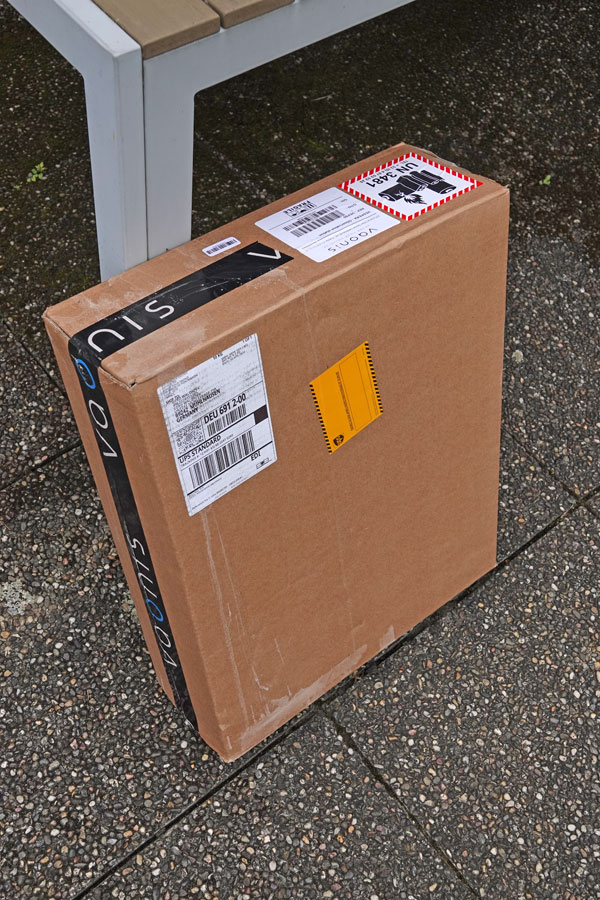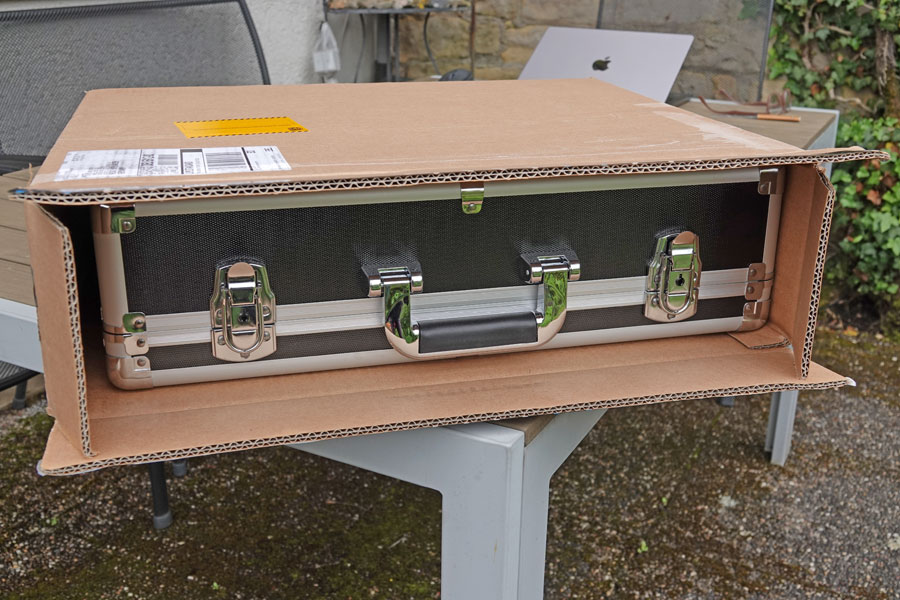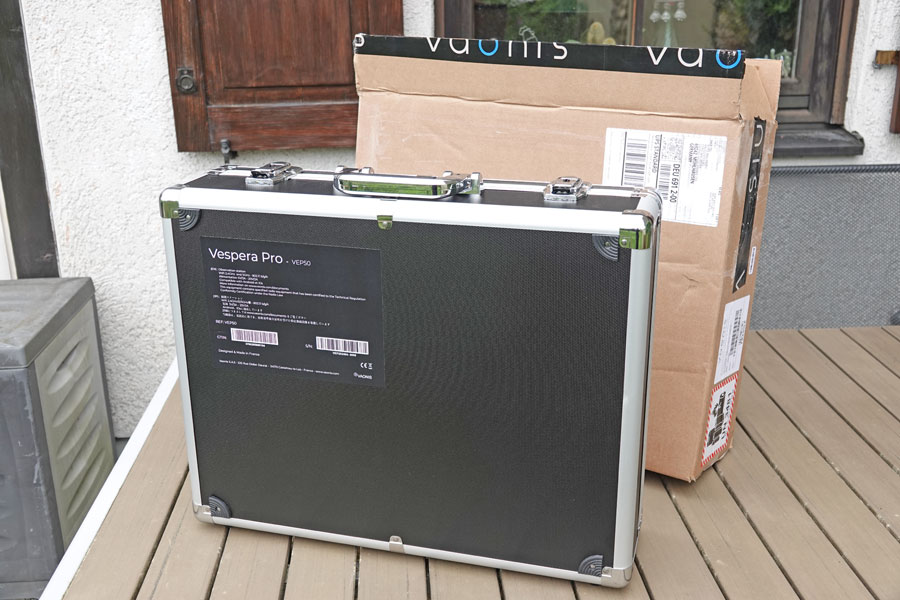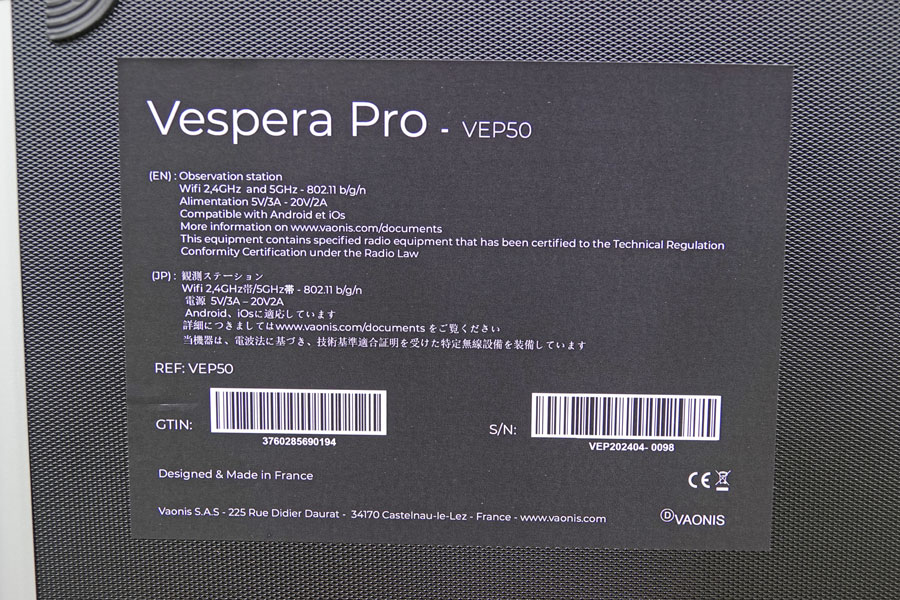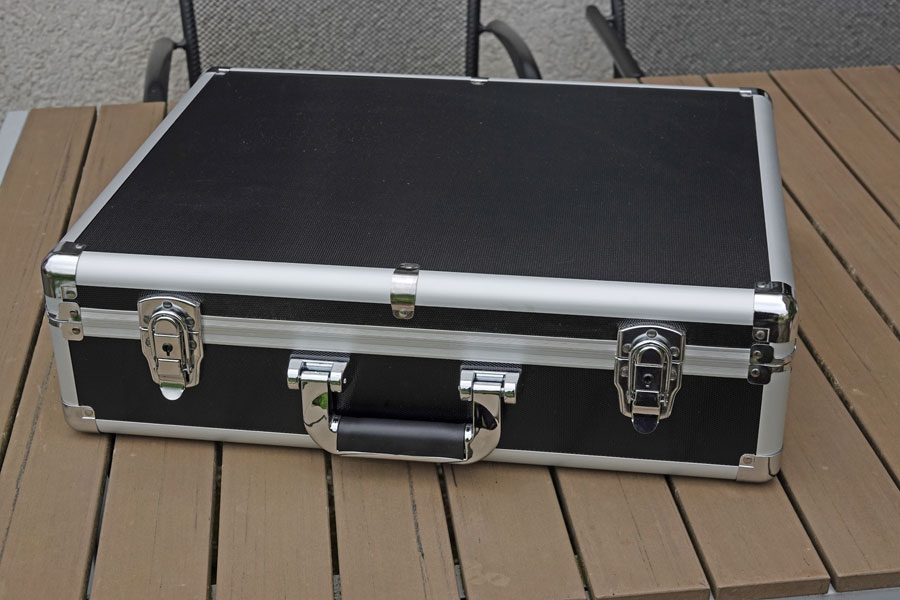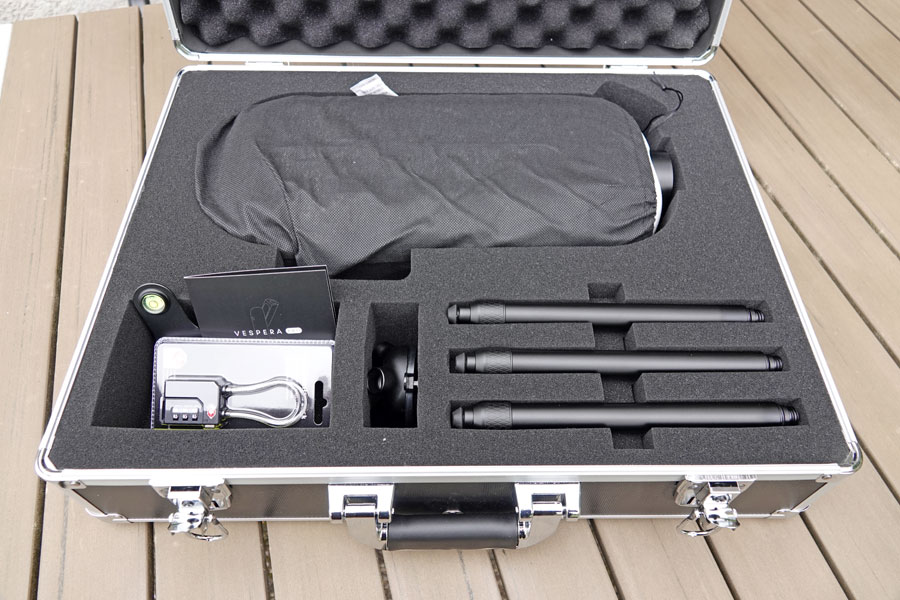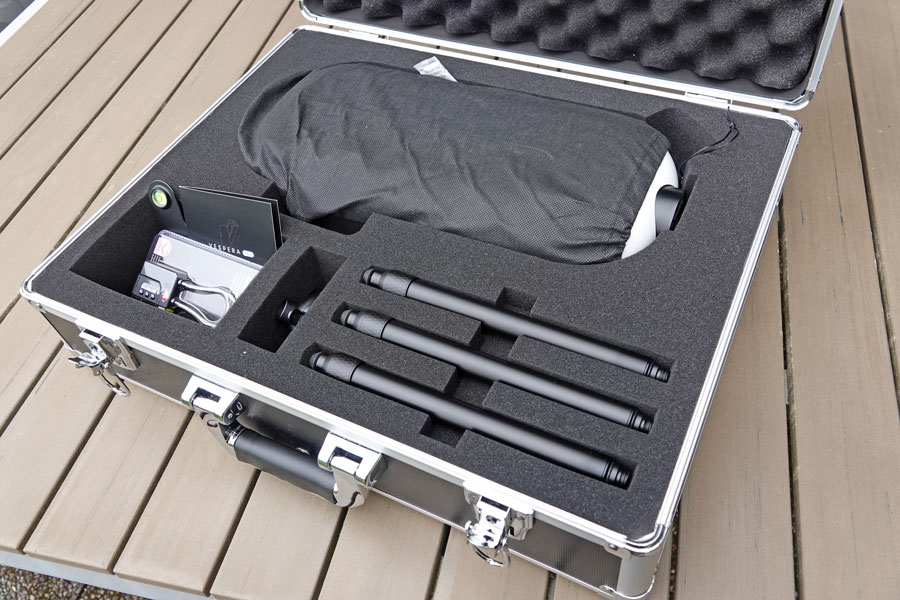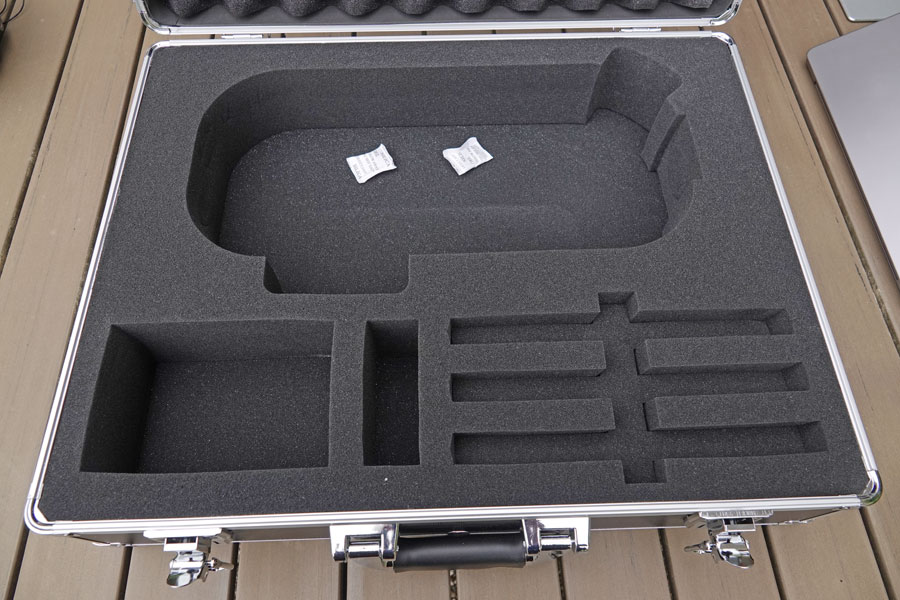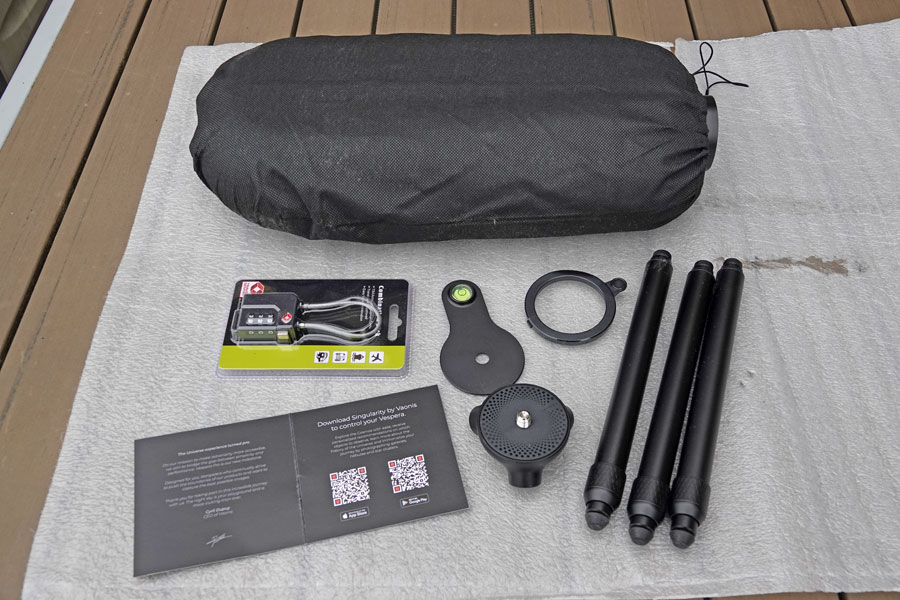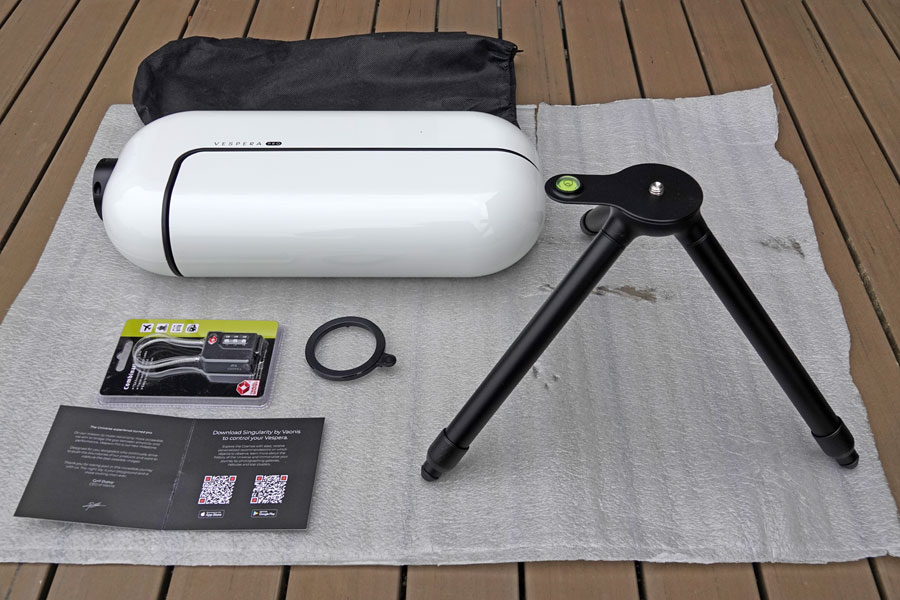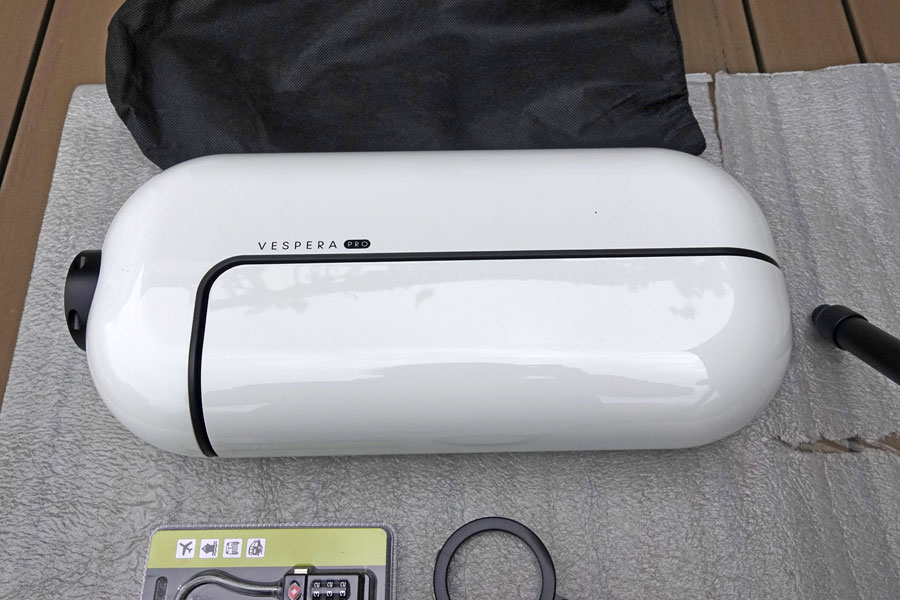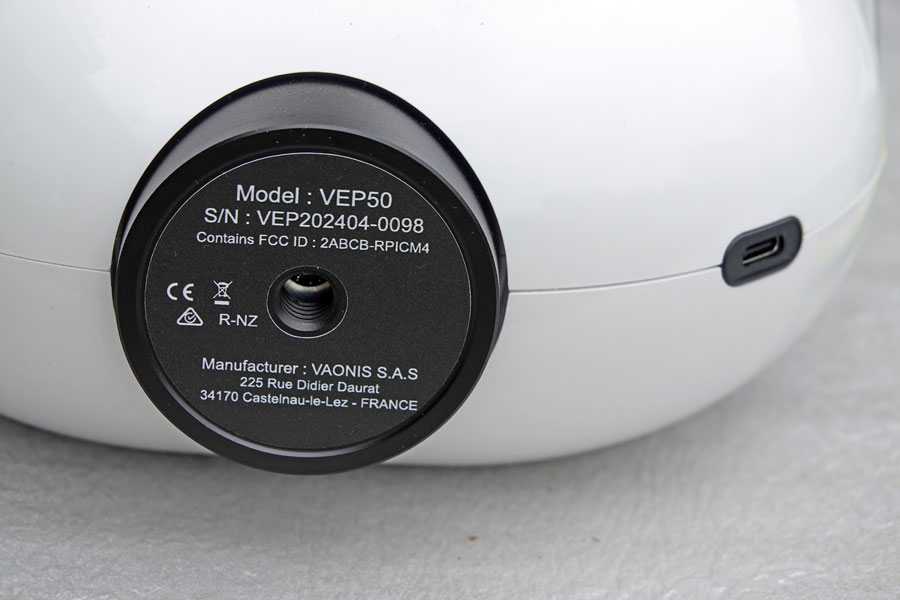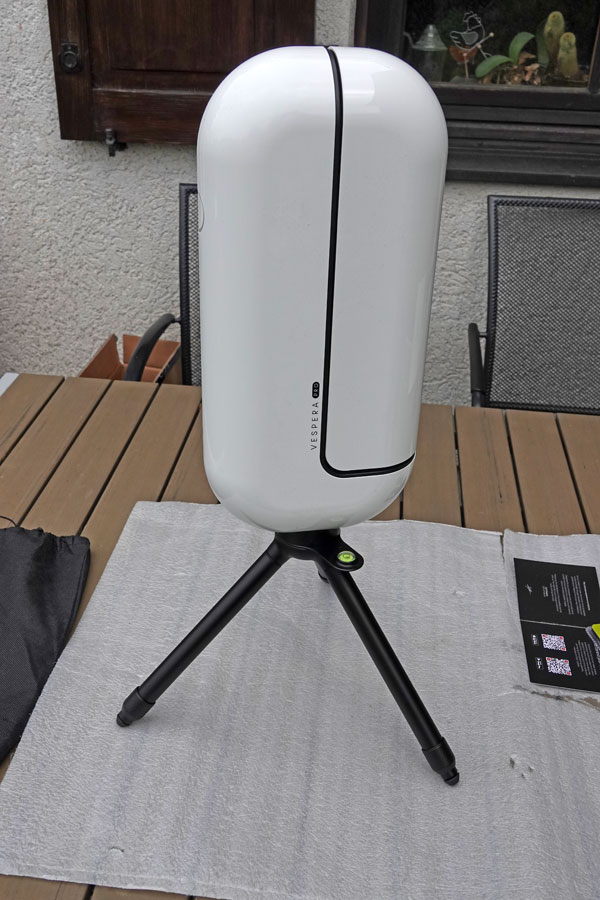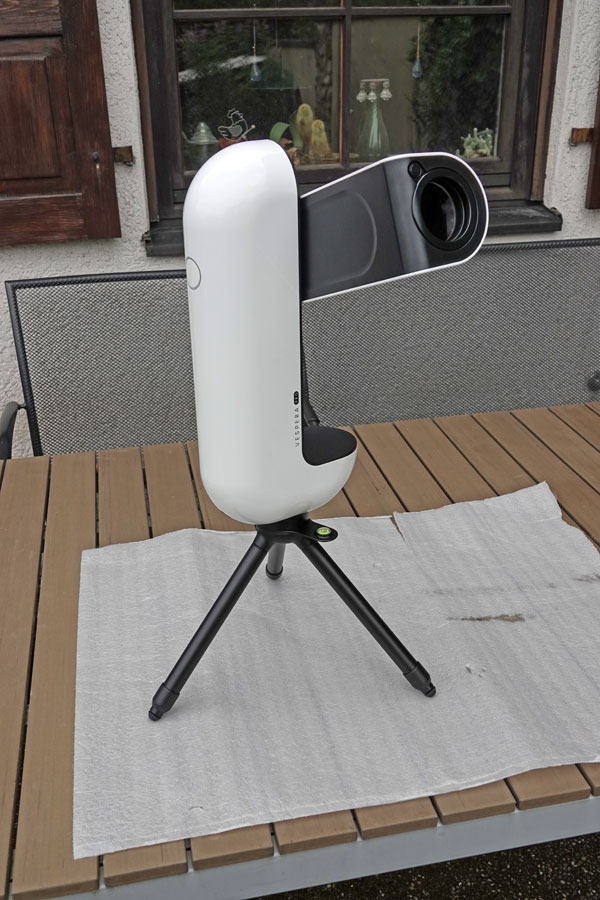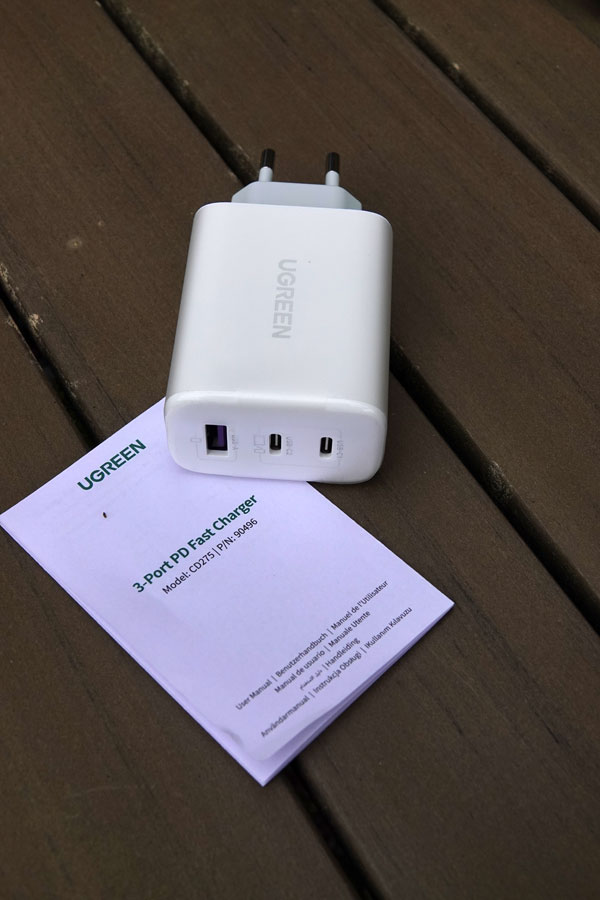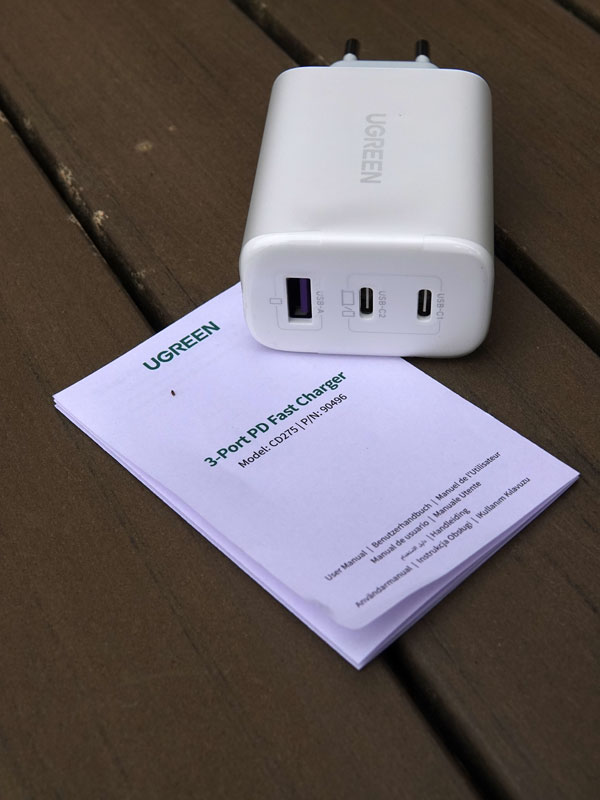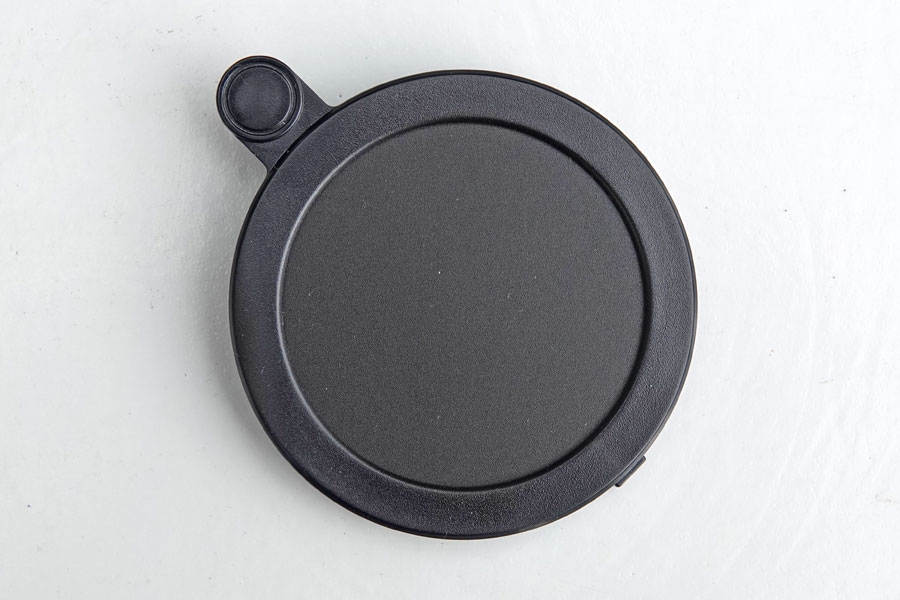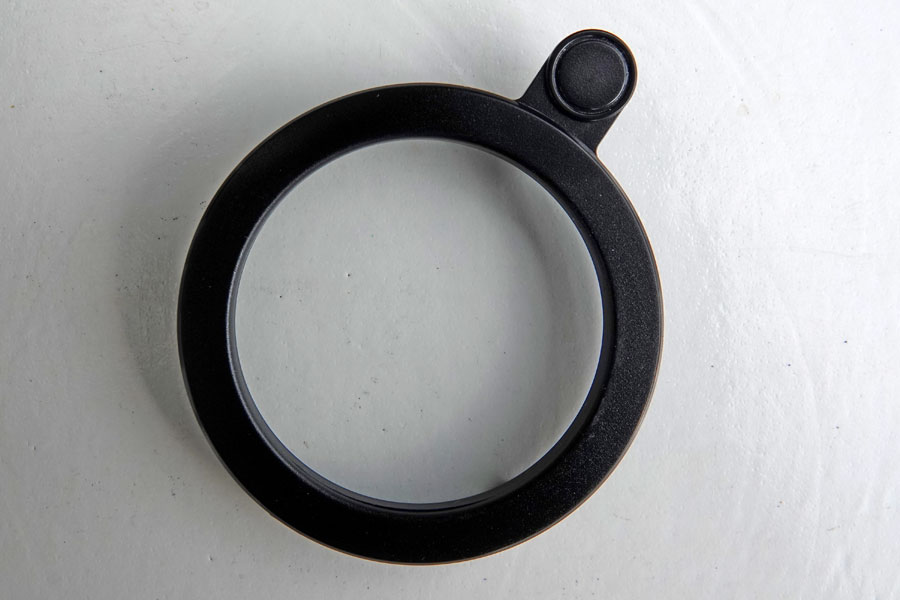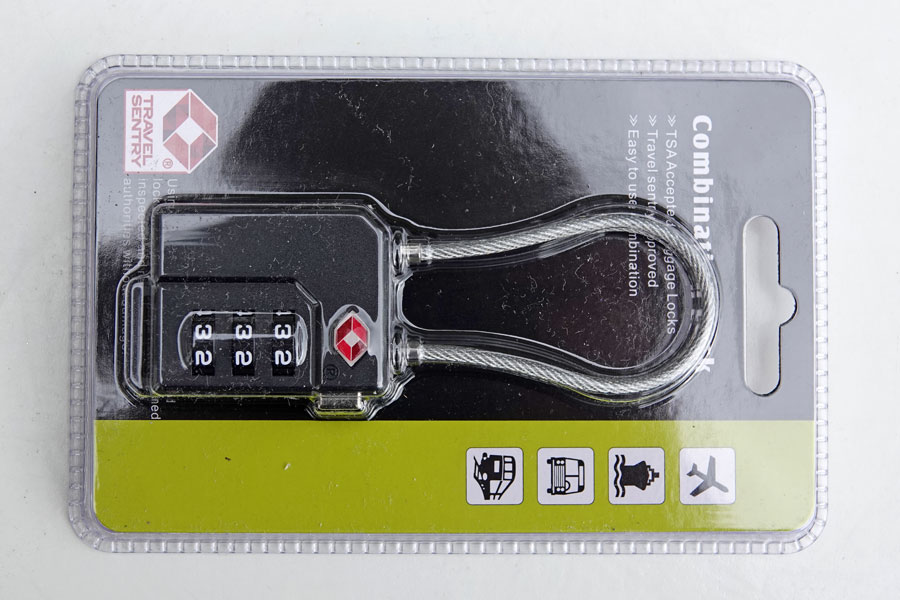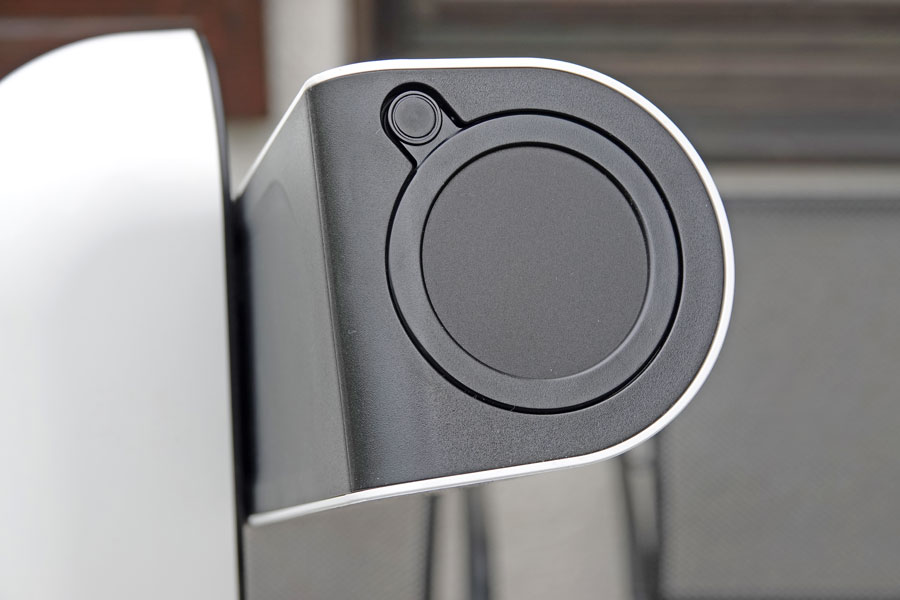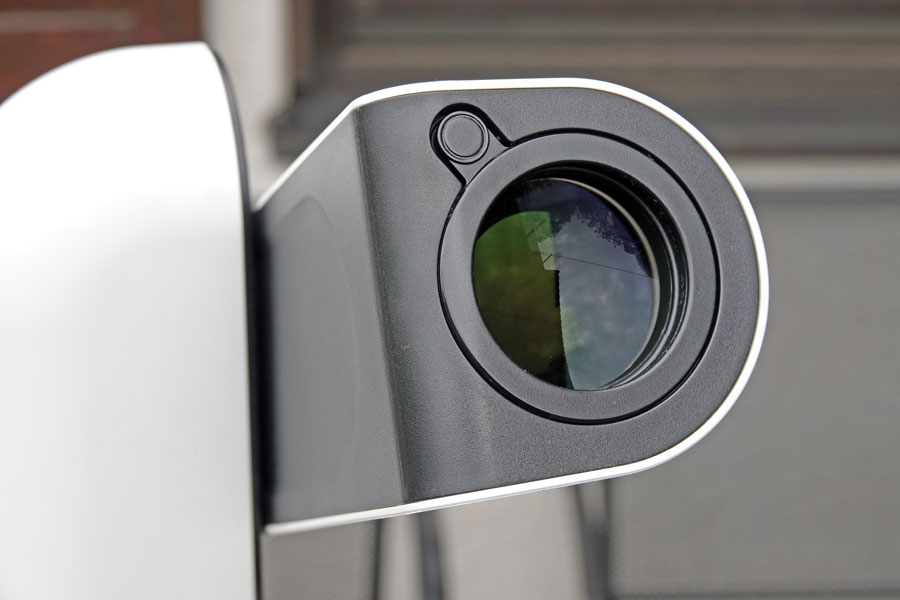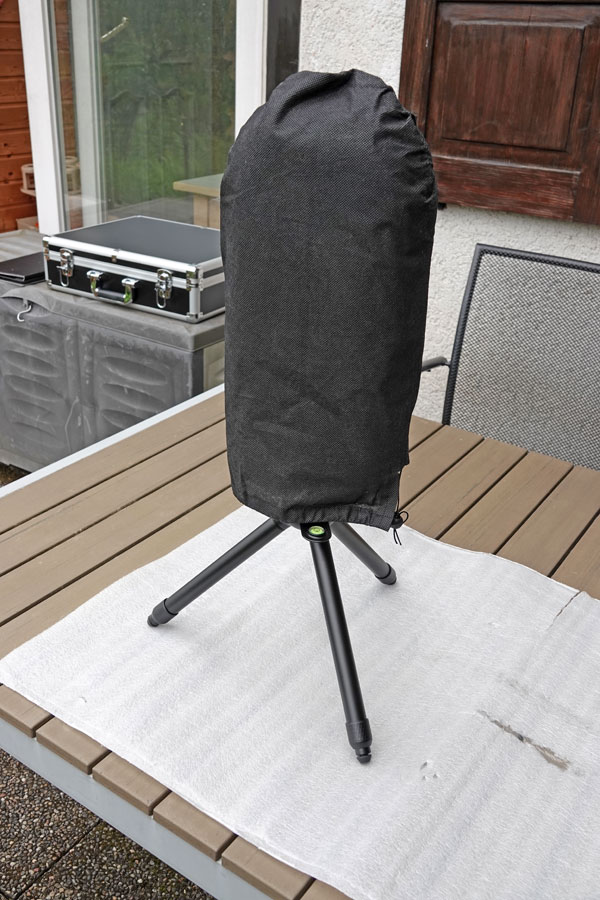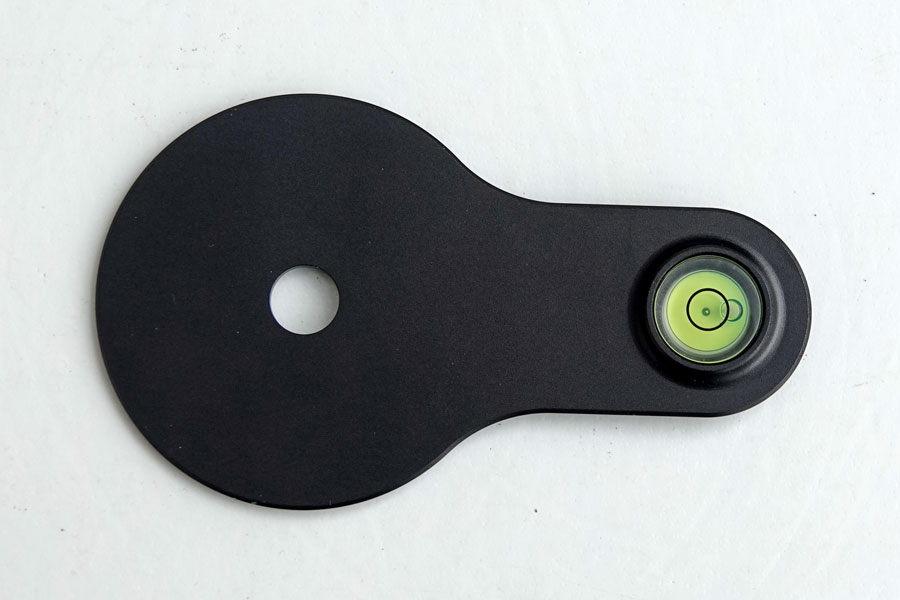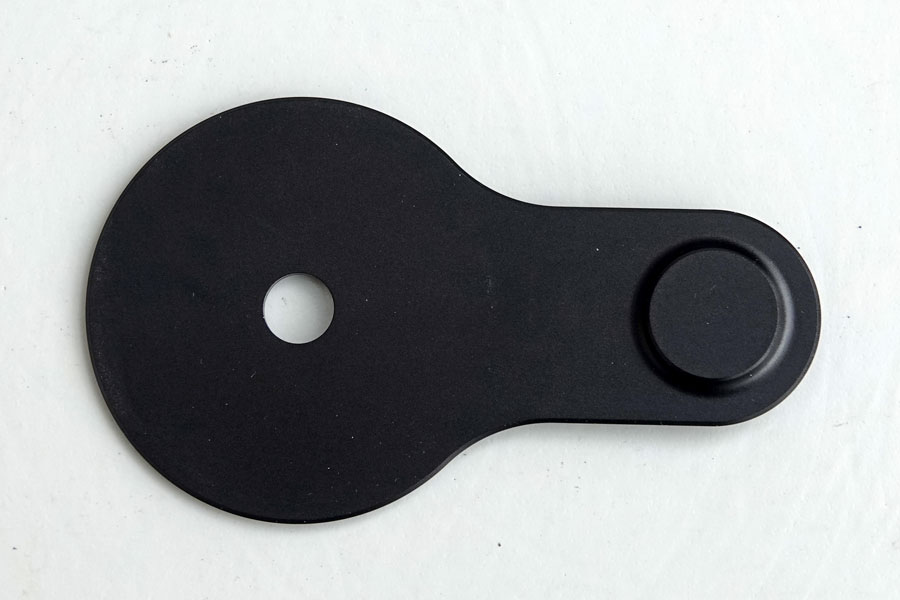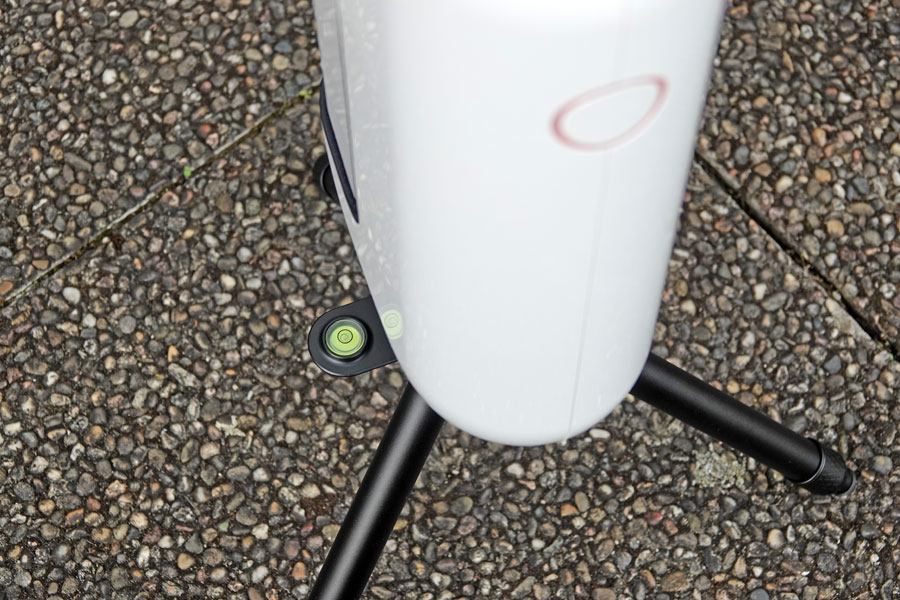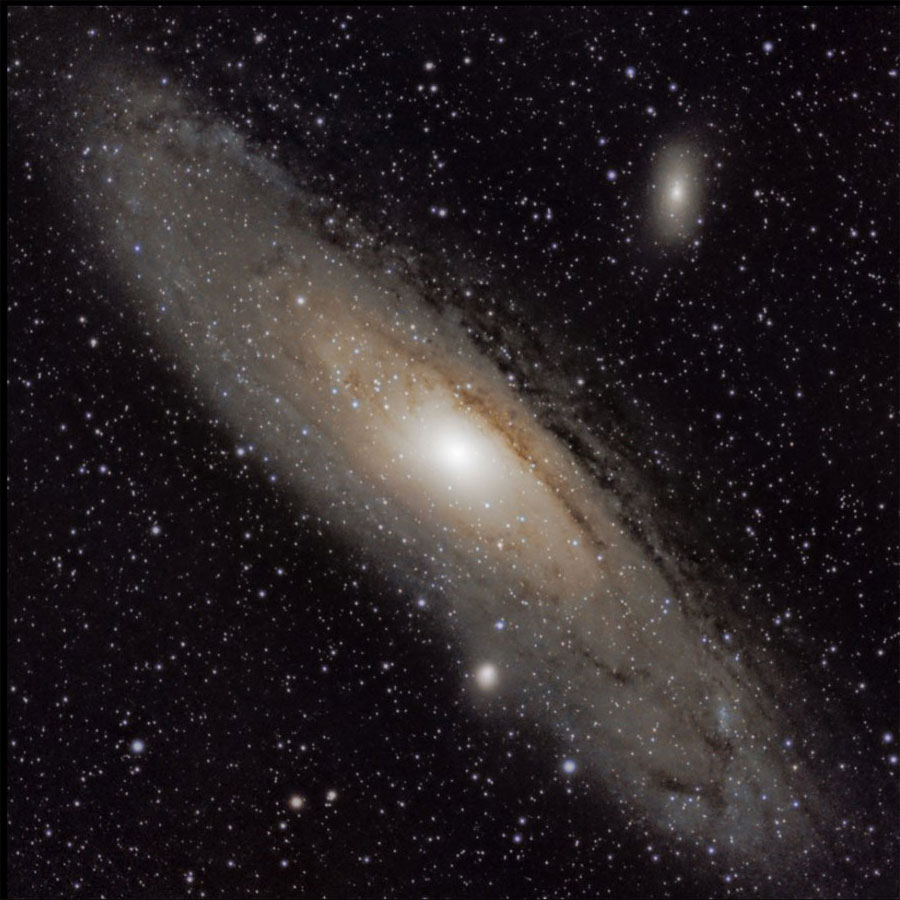Vaonis Vespera Pro - Information (2" Refractor)
Introduction | About Vespera Pro | Look | Sensor, Pixel Data, Field of View, Image Size (Pixels) | Visited Sky Objects | First Experiences and Photos | Photo Attempts | First Conclusions | Links || Appendix: Technical Data | Appendix: Comparison of the Vaonis Vespera, Vaonis Vespera Pro, and the Unistellar eVscope (2)
On this page, I provide some information about my future electronic 2" refractor telescope Vaonis Vespera Pro 50 mm/250 mm (f/5). I pre-ordered it on June 14, 2023; shipment was promised for May 2024. And that was indeed the case. UPS initially reported a delivery of my Vespera Pro on May 3, 2024, but after two sort erors it only arrived on May 8, 2024. Not too bad!
Note:
- For further information about Vaonis see the Vaonis Website, the Vespera Pro product page there, and page Vaonis Vespera - Information (original Vespera) on this site.
- Some of the photos were taken from the Vaonis Website. Vaonis granted me the permission to use their photos on my Website.
Introduction
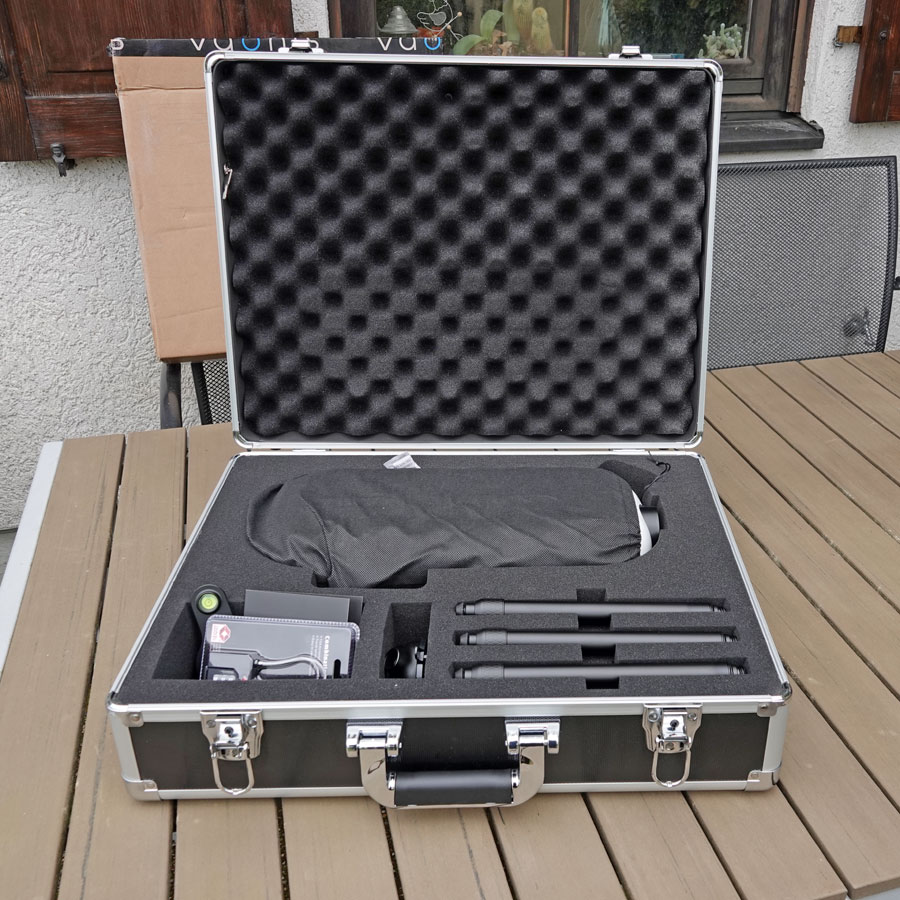 |
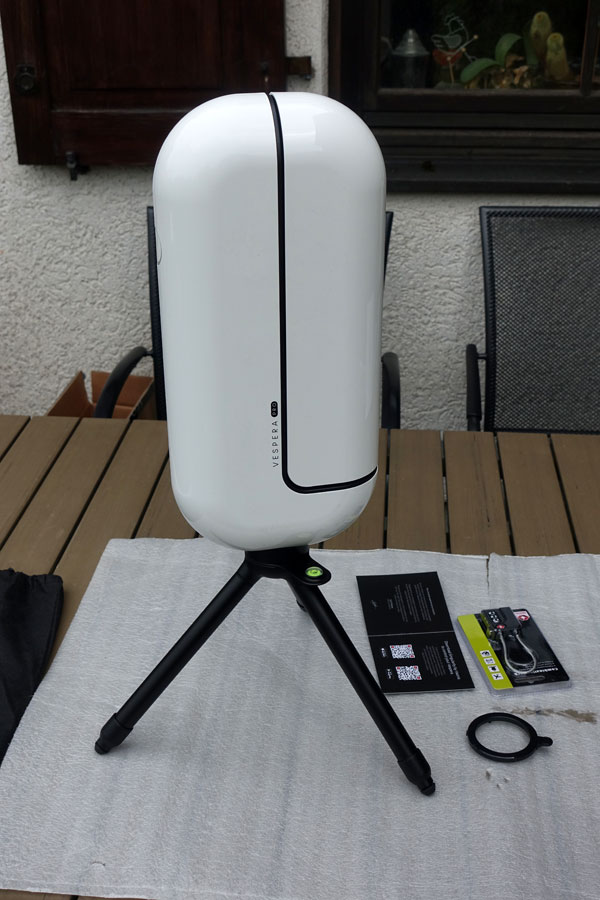 |
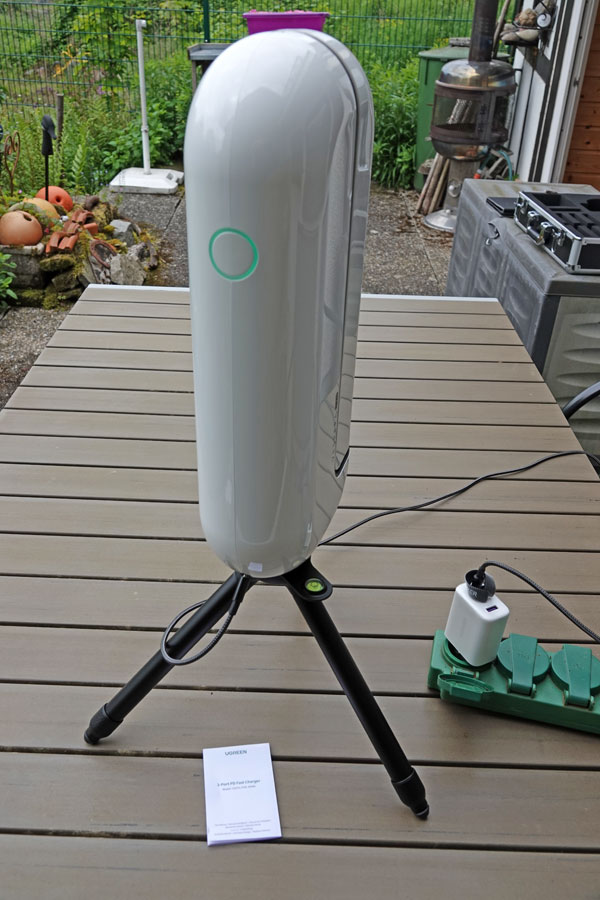 |
Photo: My Vaonis Vespera Pro (May 8, 2024)
Vespera Pro is an update of the Vespera electronic telescope from the French company Vaonis (in the meantime there appeared a version limited to 222 samples called Passenger and the successor model Vespera II). It was available for pre-order on the Vaonis Website since mid-June 2023. Delivery of the telescope was promised to take place in May 2024 for the first pre-orders and started in the beginning of May 2024. Later pre-orders were delivered from July 2024 on; the price was also gradually increased.
In the following, I try to collect information about the Vespera Pro as far as I could get them from the Vaonis Vespera Pro product page or other sources and from my experiences with my own sample (particularly the unboxing photos).
About Vespera Pro
What is Vespera Pro?
Vespera was meant to become a small and affordable version of Stellina. The Vespera Pro is an evolution of the Vespera with some changes from the original Vespera (sensor, focal length, aperture ratio). It also has some "pro features" that the other Vespera models do not offer (or did not offer initially...).
Thus, the Vespera Pro is also a refractor, the lens again is a quadruplet with 50 mm aperture (like binoculars), but with a focal length of 250 mm (aperture ratio f/5) and with a specially designed "pro" field corrector. It looks more or less identical to the other Vespera models, has the same size and weight as the other models.
The Vespera Pro uses a Sony IMX676 Starvis 2 sensor with a resolution of 3536 x 3536 pixels (12.5 MP). This delivers a field of view of 1.6° x 1.6°, which makes also the Vespera Pro a small rich field telescope. Its image scale or sampling rate is 1.65"/pixel, which is much better than that for the original Vespera (2.99"/pixel). With a weight of 5 kg and a height of 40 cm, the Vespera Pro has remained light and compact, making it an ideal travel telescope. The internal battery is said to last for 11 hours, which is quite a long time. I decided to go for the simple package without an additional high tripod (2000 EUR instead of 2500 EUR), which I had already bought.
Here are some technical data:
Technique |
Optics |
Mount |
||
|
Sensor
|
Other
|
More on this telescope on the Vespera Pro product page.
Why Did I Opt for the Vaonis Vespera Pro?
Especially since the introduction of the Mosaic mode, I am very fond of my Vespera. The appeal of the Vespera Pro for me was that the new sensor has a higher resolution and its field of view is 1.6° square. This makes the Vespera Pro almost a rich-field telescope, especially in mosaic mode (maximum 2.6° squared).
Who is Behind the Vaonis Vespera Pro?
 |
 |
|
Cyril Dupuy, founder and CEO of Vaonis, in an interview |
The manufacturer's team |
(Photos from the Vaonis-Website (EN); permission for use granted)
Vaonis is a French company based in Montpellier, France, that designs and manufactures telescopes and accessories. The company was founded in 2016 by Cyril Dupuy, a young start-up entrepreneur, after obtaining his Bachelor in Optics and Aerospace. From his experience of using different telescopes with complex installation, long user guides and recurring breakdowns, he imagined and designed Stellina, the world's first all-in-one telescope connected to a mobile app. Vaonis' products are designed and developed by specialists in optics, mechanics, electronics, material and ergonomics, giving special attention to its design, quality and safety. (From the Vaonis Website, adapted)
Look
Here I present photos of the unboxing, the telescope itself, and its initially delivered and bought accessories. Since much of it looks like the original Vespera, I will show less photos here.
The Box, the Hard Case, the Content, ...
Unpacked Hard Case Content, Telescope, ...
Charger
Vaonis does not include a charger with the Vespera Pro. You have to buy one and also a USB-C cable on your own. For more information, see page Vaonis Vespera Pro - Accessories > Charger
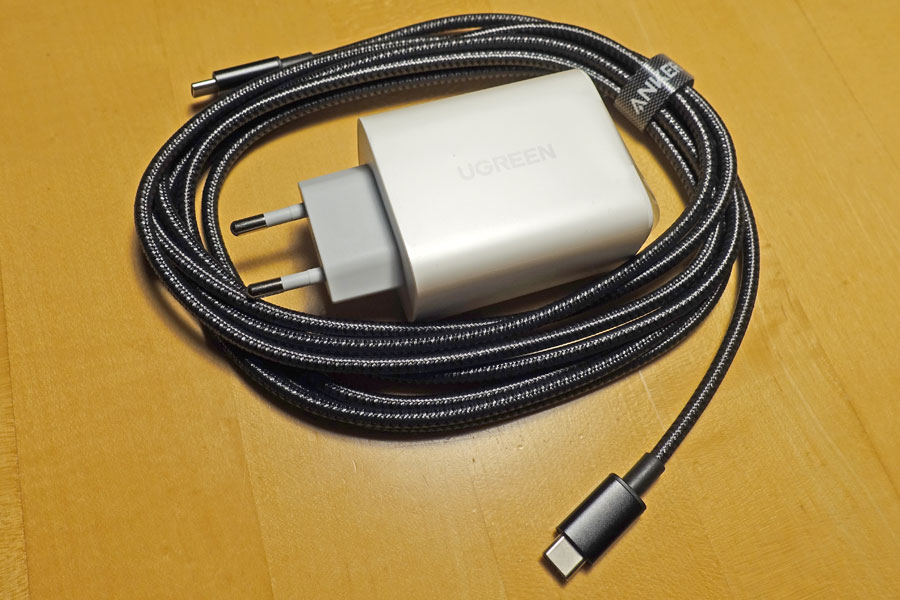 |
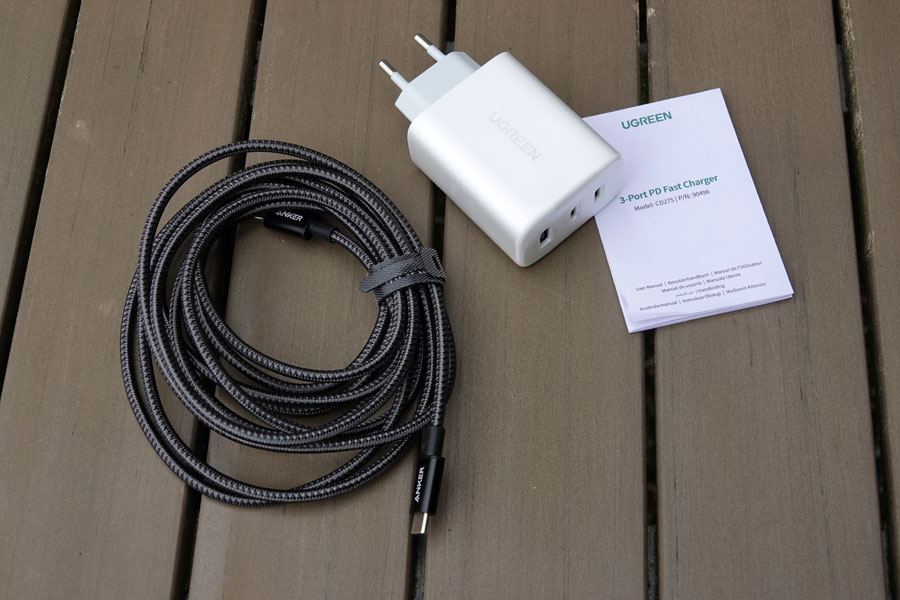 |
|||
| UGREEN USB-C charger and (extra) Anker USB-C charging cable | UGREEN USB-C charger and (extra) Anker USB-C charging cable |
|||
UGREEN USB-C charger (65 W) |
Ditto |
Vespera Pro charging |
Further Accessories
Sensor, Pixel Data, Field of View, Image Size (Pixels)
The Vespera Pro uses the new sensor Sony IMX676 (CMOS; Starvis 2), with a used pixel size of about 12.5 megapixels, or 3536 x 3536 pixels (H/V). The pixel size is 2.0 µm (quadratic pixels).
With this, all sizes are known to calculate the field of view of the Vespera, which amounts to 1.6° x 1.6°.
The following table shows the Vespera Pro, Vespera, eVscope, and eVscope 2 in comparison with my current telescope (plus the C8 that I owned) tubes at a selection of cameras that I own(ed):
Field of View |
IS* | |||||||||
| Telescope | Reducer | Focal Length |
Aperture | f | ASI224MC* | ASI294MC* | ASI462MC* | Atik Infinity* | Remarks | |
| PS 72/432 | --- | 432 | 72 | 7 | 0.65° x 0.48° | 2.54° x 1.73° | 0.74° x 0.42° | 1.19° x 0.89° | The largest FOV of my tubes | |
| C5 | --- | 1250 | 127 | 10 | 0.22° x 0.17° | 0.88° x 0.60° | 0.26° x 0.15° | 0.41° x 0.31° | FOV like C8 with reducer | |
| C5 | f/6.3 | 787.5 | 127 | 6.3 | 0.36° x 0.17° | 1.40° x 0.95° | 0.41° x 0.23° | 0.65° x 0.49° | FOV a little smaller as with TLAPO1027 | |
| C8* | --- | 2032 | 203 | 10 | 0.14° x 0.1° | 0.54° x 0.37° | 0.16° x 0.09° | 0.25° x 0.19° | The smallest FOV | |
| C8* | f/6.3 | 1280 | 203 | 6.3 | 0.22° x 0.16° | 0.86° x 0.58° | 0.25° x 0.14° | 0.4° x 0.3° | FOV like C5 | |
| TLAPO1027* | --- | 714 | 102 | 7 | 0.39° x 0.29° | 1.54° x 1.05° | 0.45° x 0.26° | 0.72° x 0.54° | FOV a little larger than for C5 with reducer | |
| in Degrees | in Minutes | |||||||||
| eVscope* | --- | 450 | 114 | 4 | 0.61° x 0.46° | 36.7' x 27.6' | 1.72 | Same sensor as ASI224: Sony IMX224 | ||
| eVscope 2* | --- | 450 | 114 | 4 | 0.78° x 0.57° | 47' x 34' | 1.33 | New sensor: Sony IMX347 | ||
| Vespera* | 200 | 50 | 4 | 1.6° x 0.9° | 96' x 54' (ca.) | 2.99 | Same sensor as ASI462: Sony IMX462 | |||
| Vespera Pro | 250 | 50 | 5 | 1.6° x 1.6° | 96' x 96' (ca.) | 1.65 | New sensor: Sony IMX676 | |||
*) No longer in my possession
*) IS = image scale: describes the relative sizes of objects at 1:1 pixels (the larger the number, the smaller the objects)
Image Size (Pixels)
Sony's IMX676 sensor can be used with 3536 x 3536 pixels (12.5 MP; recommendation by Sony). However, the resulting photos may often be somewhat smaller because they are automatically cropped, probably in response to field rotation.
Field of View (FOV)
The Vespera Pro has nearly double the FOV of the Vespera (calculated with astronomy.tools):
Vespera Pro in red (Custom Camera)
Simulation of the FOV by Vaonis, rotated for 180° (product page for Vespera Pro):
And another comparison with the Sky-Watcher EvoGuide 50ED (calculated with astronomy.tools):
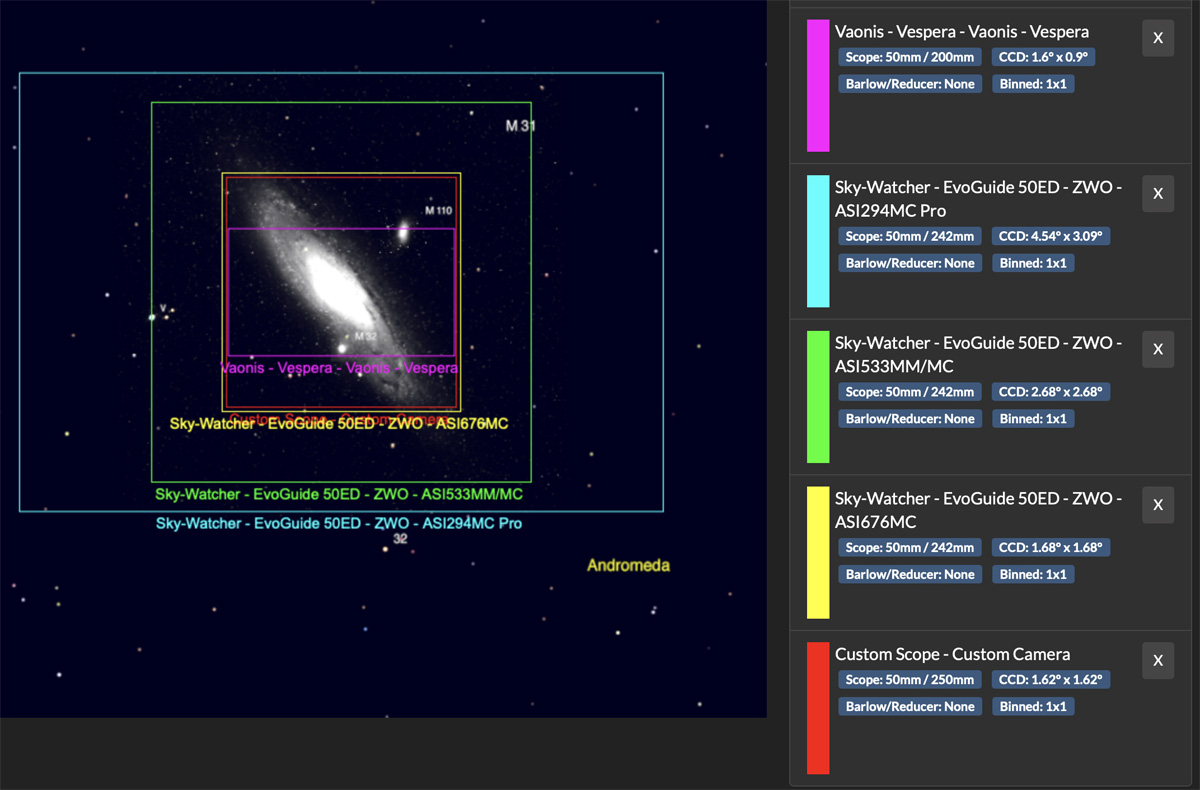
The EvoGuide 50ED with ASI676 and the Vespera Pro have nearly identical FOVs; Vespera Pro in red (Custom Camera)
Field of View in Mosaic Mode
4.18° x 2.45° or 3.2° x 3.2°
Visited Sky Objects
These are the very first DSO (during the first two months) and objects that I observed with my Vespera Pro:
- May 9, 2024: Sun spots (one was ery large)
- May 10, 2024: M 95, M 96, M 105, and several small galaxies; M 81, M 82, and several small galaxies
- May 12, 2024: M 64 (30 min); M 63 (briefly)
- May 13, 2024: M 51 (7:50 min); M 63 (25 min)
- May 14, 2024: M 104 (30 min); M 64 (30 min); M 86 (Markarian's Chain; 30 min) - many galaxies
- May 22, 2024: M 101, M 106, M 97/108, NGC 4565
- May 25, 2024: M 51, M 97/108, NGC 4631
- June 4, 2024: M 5, M 13, M 92, M 109
- June 7, 2024: M 3, M 5, M 53, M 101, NGC 5005, NGC 5033, NGC 5053
- June 24, 2024: NGC 6960, NGC 6992/5
- June 25, 2024: M 8, M 20, M 27
- June 28, 2024: M 11, M 14, M 16, M 17
All the DSO that I observed with my Vespera Pro can be found on page My Deep Sky Observations with the Vespera Pro (Complete List of Observed DSO). A few sample photos:
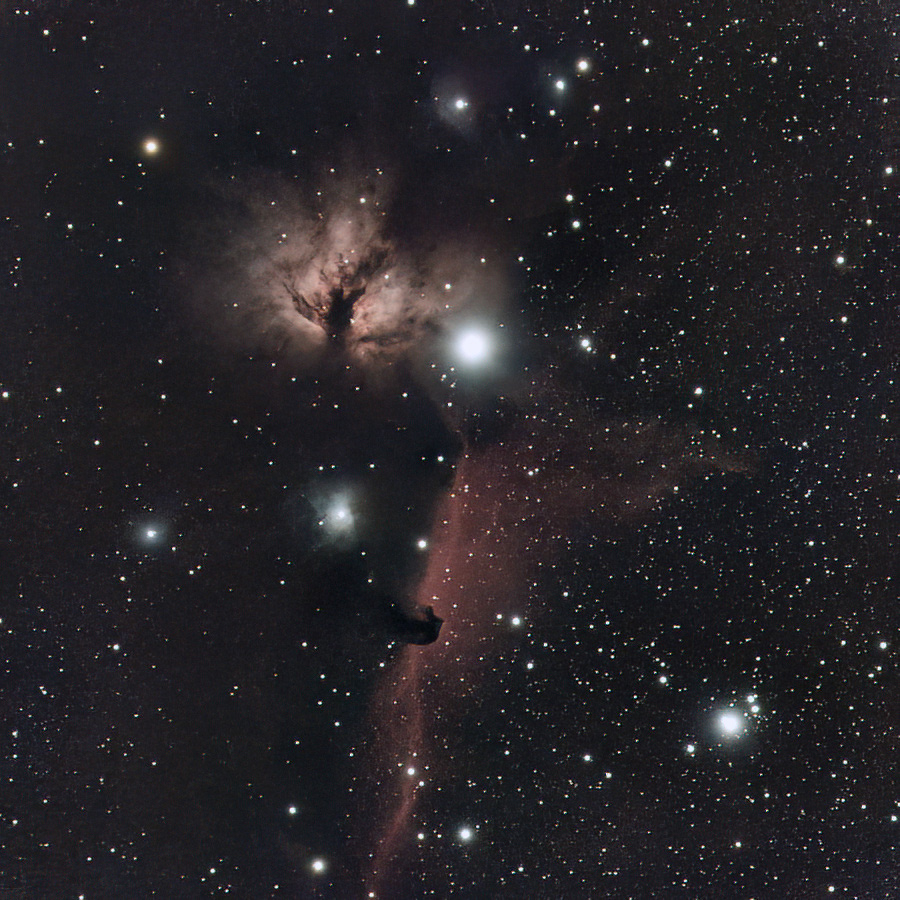 |
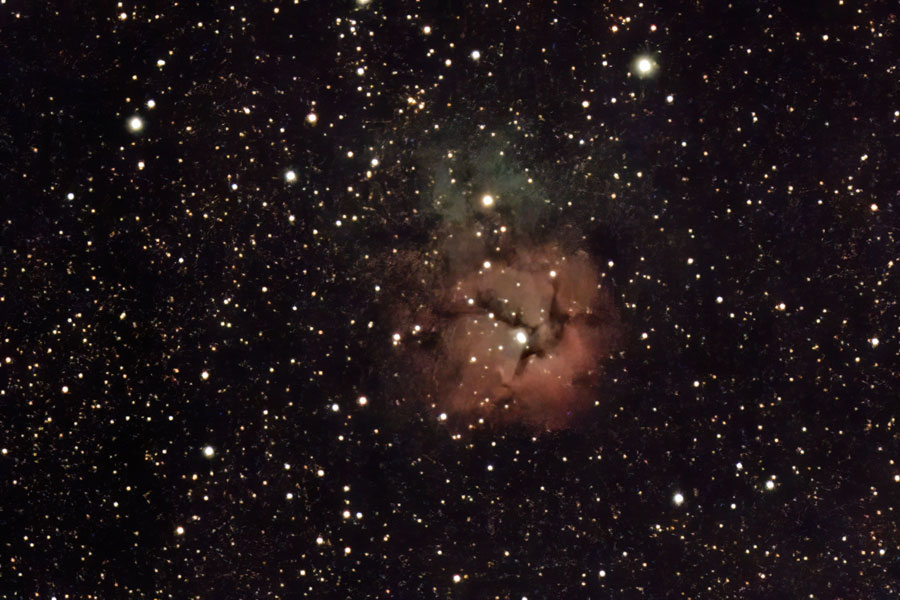 |
|
NGC 2024 und B 33 mit NGC 2023, 26.12.2024 - groß (2740 s), TIFF zusätzlich entrauscht (DN) und Farbton korrigiert |
M 20 - Jun 25, 2024, 1800p (217 frames, 2170s), mosaic, 1:1 section, processed (PSE) and denoised (DN) |
|
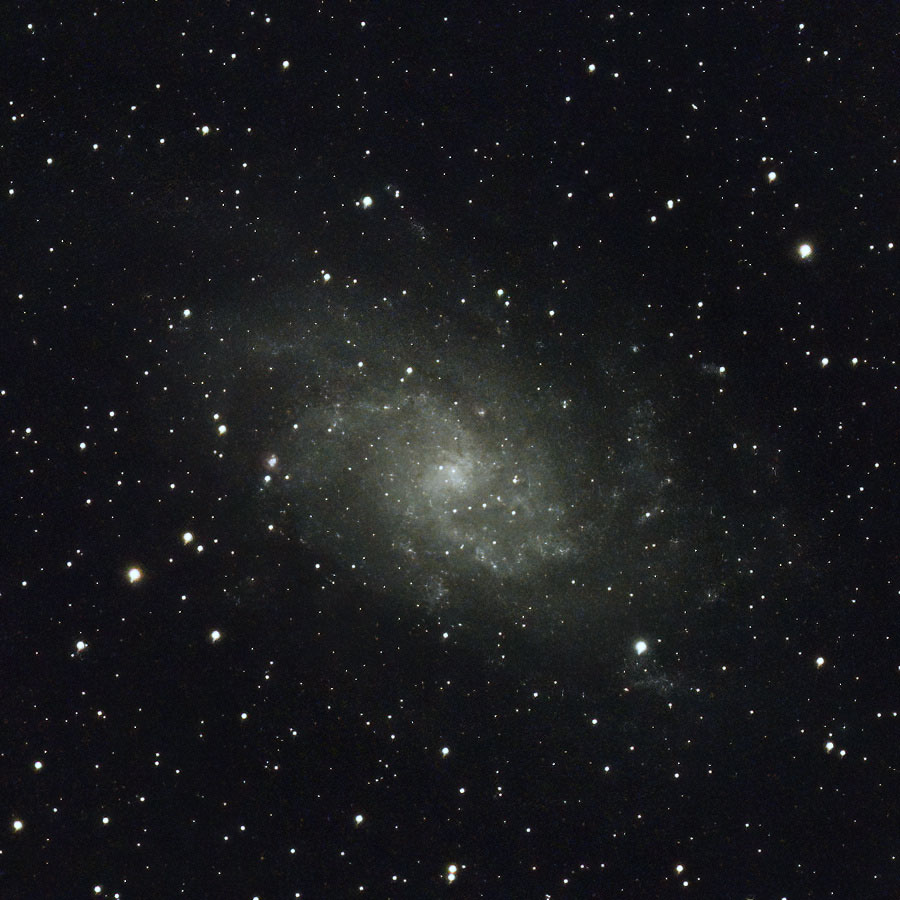 |
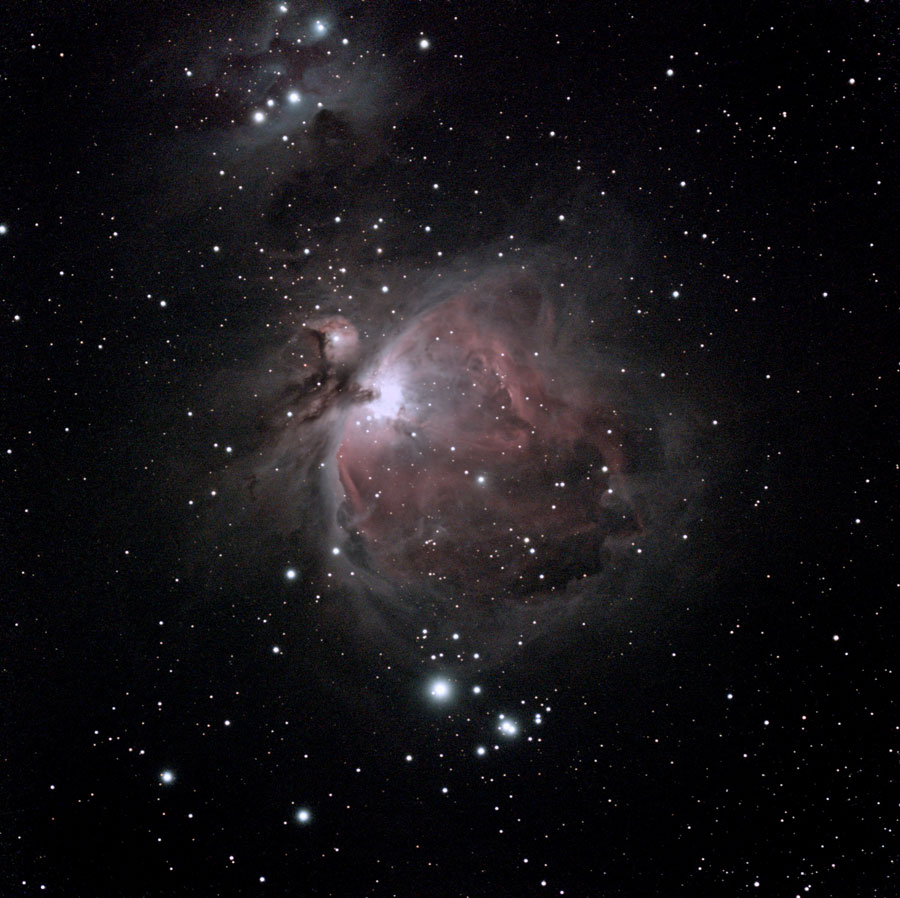 |
|
M 33 - Nov 3, 2024, 2100 (361 frames = 1 h), section, processed (Siril, AP) and denoised; with white balance |
M 42/43 with NGC 1977 and NGC 1980, Dec 26, 2024 - 2000 (121 Frames = 20 min), processed, white balance |
|
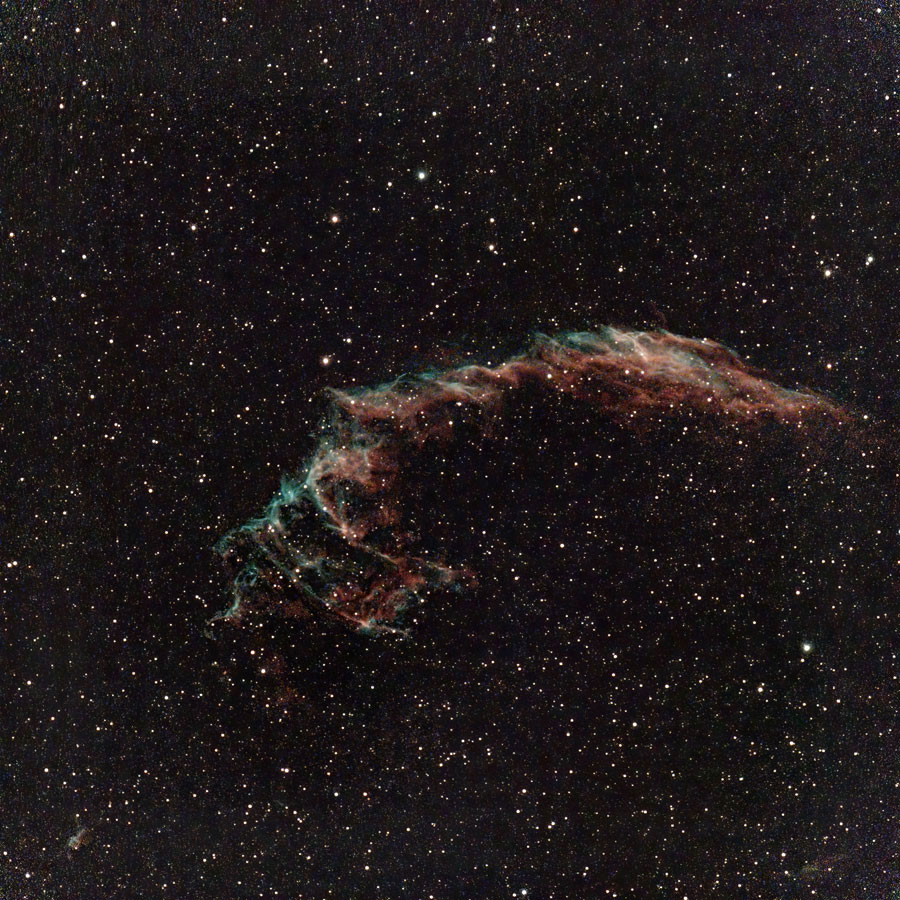 |
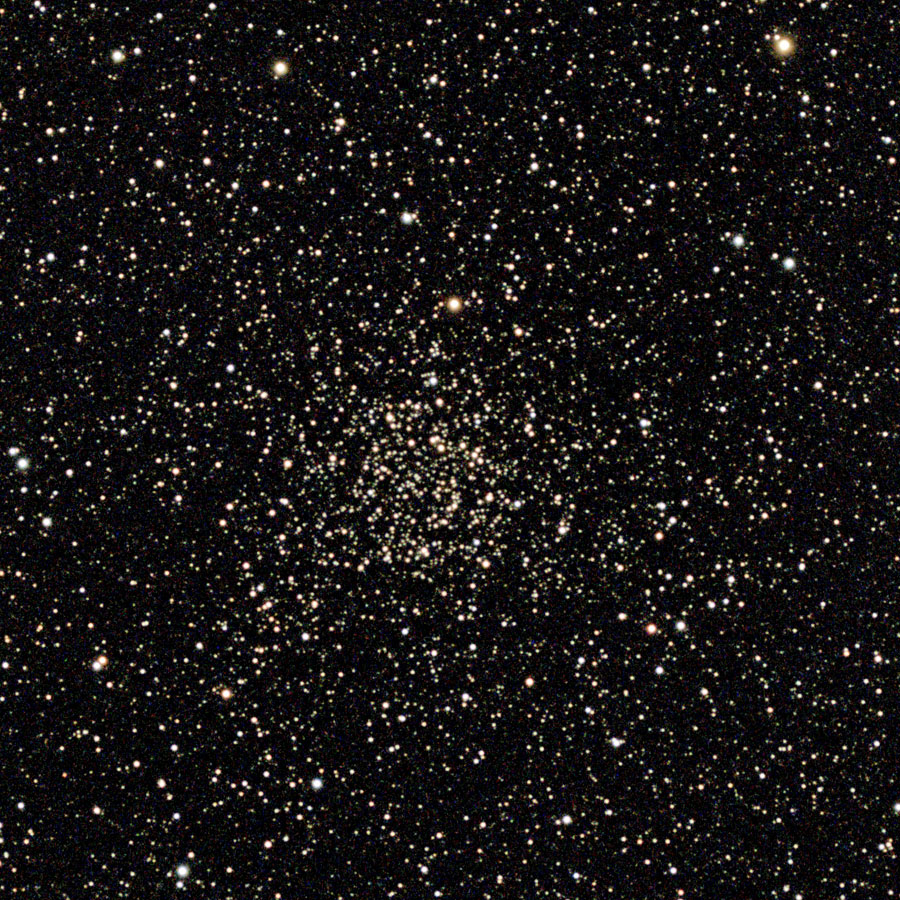 |
|
| NGC 6992/5, Dec 26, 2024 - 2000 (241 frames = 40 min), TIFF processed, denoised, and further processed | NGC 7789, Aug 25, 2024 - 1800p (90 frames = 900s), section, processed |
First Experiences and Photos
For space reasons, I moved my first experiences with and photos taken with my Vespera Pro to a seperate page.
First Conclusions
I had high hopes for the Vaonis Vespera Pro, thanks in part to the full-bodied advertising by Vaonis. I waited almost a year for it until I actually received it (on time) at the beginning of May 2024. In the meantime, however, I kept asking myself whether I had made the right choice.
Although the new sensor offers a higher resolution than its predecessor, many amateur astronomers consider its predecessor to be the better telescope. Its successor, the Vespera II, is also rated better by many than the Vespera Pro, mainly because it produces faster results, that is, it requires significantly shorter exposure times for a similar result (about half the time...). In addition, the photos of the Verspera Pro are much noisier than those of the Vespera and the Vespera II due to the small pixels (2.0µm). The noise of the Vespera Pro is said to become "acceptable" only after an hour of exposure time, sometimes it takes even longer (the new trend is to expose for days, but this applies to all Vesperas)... For me as an old EAA user who liked to observe 20-30 objects in the evening, this is of course nothing! That is why I "muddle through" with relatively short exposure times and leave the denoising to the software. This sometimes works well and sometimes less well.
However, there are also some arguments in favor of the Vespera Pro! I find the square sensor much better than the "towel format" sensors of the Vespera and Vespera II (HD format). This should also have advantages for mosaics because larger areas can be used when assembling the mosaic. This allows you to make more passes, but I have not really seen any faster results yet... In principle, the new sensor also shows more detail, and the objects are slightly larger, which is an advantage over the Vespera for many tiny DSOs (I have not compared the Vespera II yet).
As the "top model" of Vaonis, only the Vespera Pro had initially dithering for normal photos (since the beginning og 2025, they all dither - as the did for mosaics already before that). I found that quite pleasant, because I do not always want to take mosaics! With normal shots, I can stop exposing when I am satisfied with the quality and I do not have to wait for a "mosaic round" to complete. With a comparable integration time, a normal shot should also have a better quality than a mosaic shot.
The latest achievement, again reserved for the Vespera Pro, was the introduction of master darks at the beginning of 2025, which should lead to a general improvement in image quality (including less noise). I have not found any impovement yet, though...
Since the last update of the software (Feb 25, 2025) the photos are very noisy (and the sky background too bright) and moon photos wash out irretrievably in the bright areas. Vaonis has promised to look into the matter...
All in all, I hope, of course, that I can make friends with my Vespera Pro after all...
Links
- Vaonis: vaonis.com/fr (FR), vaonis.com (EN)
- Vespera Pro product page: vaonis.com/vespera-pro
- See also my page offering Astronomy Links.
Appendix: Technical Data for the Vaonis Vespera Pro
Hardware
- Magnification: 40 x optical???
- Maximum magnitude: up to 16 mag in good sky
- Aperture: 50 mm
- Focal length: 200 mm
- Focal ratio: 1:5
- Motorized Alt-AZ mount
- Weight: 5 kg
- Size: 15 x 8 x 3.5 in (40 x 20 x 9 cm)
Bag
- Same as the one for the Vespera (optional)
Electronics
- Sensor model: Sony IMX676 (CMOS, Starvis 2) - for details see further below
- Battery life: up to 11 hours (internal battery)
- Wireless connectivity: Wifi for smartphone or computer control and GPS access (no GPS inside)
Smarts
- Autonomous field detection
- Fully automated star alignment procedure
- Automated pointing
- Automated celestial tracking
- Intelligent image processing
Sensor Data
- Sony Starvis 2 IMX676 color CMOS sensor - 12.5 MPixels
- Sensor size: 1/1.6", 3536 x 3536 pixels
- Pixel size: 2.0µm x 2.0µm
- Read noise: < 0.5e-???
Appendix: Comparison of the Vaonis Vespera, Vaonis Vespera Pro, and the Unistellar eVscope (2)
| Vespera | Vespera Pro | eVscope | eVscope 2 | |
| Weight | 5 kg (11 lbs) | 5 kg (11 lbs) | 9 kg (19.8 lbs) including tripod |
9 kg (19.8 lbs) including tripod |
| Height | 40 cm (15 in) | 40 cm (15 in) | 65 cm (25.5 in) | 65 cm (25.5 in) |
| Width | 20 cm (8 in) | 20 cm (8 in) | 23 cm (9 in) | 23 cm (9 in) |
| Depth | 9 cm (3.5 in) | 9 cm (3.5 in) | n.a. | n.a. |
| Telescope type | Refractor | Refractor | Reflector (Newtonian) | Reflector (Newtonian) |
| Lens/Mirror | Apochromatic Quadruplet | Apochromatic Quadruplet | mirror | mirror |
| Lens/Mirror special features | Extra low dispersion S-FPL52 equivalent (ULD) with lanthanum glass | Extra low dispersion S-FPL52 equivalent (ULD) with lanthanum glass | BK7 glass mirror | BK7 glass mirror |
| Aperture | 50 mm | 50 mm | 112 or 114 mm | 112 or 114 mm |
| Focal length | 200 mm | 250 mm | 450 mm | 450 mm |
| Focal ratio | F/4 | F/5 | F/4 | F/4 |
| Field of view | 1.6° x 0.9° | 1.6° x 1.6° | 0.61° x 0.46° (36.7' x 27.6') | 0.78° x 0.57° (47' x 37') |
| Mount | Alt-azimuth | Alt-azimuth | Alt-azimuth | Alt-azimuth |
| Field derotator | no, done in software | no, done in software | no, done in software | no, done in software |
| Image sensor | Sony IMX462 | Sony IMX676 | Sony IMX224 | Sony IMX347 |
| Resolution | 1920 x 1080 (2 MP) | 3536 x 3536 (12.5 MP) | 1280 x 960 (1,2 MP) / 2560 x 1920 (2.4 MP) scaled (EV mode) | 2048 x 1536 (3.2 MP), 3200 x 2400 (7.7 MP) scaled (EV mode) |
| Sensor size | 1/2.8" | 1/1.6" | 1/3" | 1/1.8" |
| File formats | JPEG, TIFF, FITS (TIFF/FITS in 16 bits) | JPEG, TIFF, FITS (TIFF/FITS in 16 bits) | PNG | PNG |
| USB port (pictures download) | no (with Wi-Fi) | no (with Wi-Fi) | no (with Wi-Fi) | no (with Wi-Fi) |
| Autofocus | yes | yes | no | no |
| Light pollution filter | Optional | Optional | no, done in software | no, done in software |
| Dew control | Yes as soon as the (optional) sensor is installed | yes | no | no |
| Temperature/humidity sensor | Optional | yes | no | no |
| Battery type | Integrated | Integrated | Integrated | Integrated |
| Battery life | up to 8 h | up to 11 h | up to 10 h | up to 10 h |
| Water resistance | IP43 | IP43??? | n.a. | n.a. |
| Multi user mode | up to 8 users | up to 8 users | yes (number unknown) | yes (up to 10 users) |
| Number of objects in data base | 300+ (July 2023) 4000 (extended) |
300+ (July 2023) 4000 (extended) |
> 5000, > 120 with descriptions | > 5000, > 120 with descriptions |
| Object access via coordinates | yes | yes | yes | yes |
| Solar pointing | yes (with optional filter) | yes (with optional filter) | yes (with optional filter) | yes (with optional filter) |
| Connected battery | possible | possible | possible | possible |
| Connection to Wi-Fi hotspots | no | no | no | no |
| Scheduling of observations | yes | yes | no | no |
| Expert mode (camera control) | yes | yes | manual pre-processing (brightness, background) already available in 2020 | manual pre-processing (brightness, background) |
| HDR Image processing | yes | yes | no | no |
| Pictures stocking in the app | up to 200 MB | up to 200 MB | no, on the smartphone depending on its memory size | no, on the smartphone depending on its memory size |
| Mosaic mode | 3.2° x 1.8° (4 x sensor field) at maximum, up to 8 MP | 3.2° x 3.2° (4 x sensor field) at maximum, up to 50 MP | no | no |
| 30.03.2025 |
